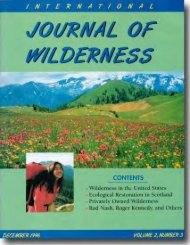Download full PDF - International Journal of Wilderness
Download full PDF - International Journal of Wilderness
Download full PDF - International Journal of Wilderness
Create successful ePaper yourself
Turn your PDF publications into a flip-book with our unique Google optimized e-Paper software.
on the committee. In addition, the<br />
author <strong>of</strong> the Negotiated Rulemaking<br />
Act, Philip Harter, was selected as a<br />
neutral mediator <strong>of</strong> the process.<br />
Issues and<br />
Outcomes <strong>of</strong> the Process<br />
The central topics during the negotiated<br />
rulemaking were the interpretations<br />
<strong>of</strong> Sections 2(c) and 4(c) <strong>of</strong> TWA.<br />
Section 2(c) defines wilderness as being<br />
“without permanent improvements,”<br />
while Section 4(c) states that<br />
“there shall be no temporary road, no<br />
use <strong>of</strong> motor vehicles, motorized<br />
equipment or motorboats, no landing<br />
<strong>of</strong> aircraft, no other form <strong>of</strong> mechanical<br />
transport, and no structure or installation<br />
within any such area.”<br />
Harter (2000, p. 2) states that the confusion<br />
in interpreting the term installations<br />
stems from the fact that “the<br />
language <strong>of</strong> the Act is unmistakably<br />
<strong>of</strong> the Sixties, as indeed is its vision<br />
… it is the only natural resource law<br />
with a soul.”<br />
Opponents <strong>of</strong> the ban argued that<br />
the anchors left by climbers are comparable<br />
to materials left by many<br />
other visitor groups (see Figure 2).<br />
They stated that hunters leave behind<br />
thousands <strong>of</strong> bullets, cartridges, and<br />
shotgun shells, while anglers lose<br />
hooks, lures, flies, and sinkers. Contending<br />
that the authors <strong>of</strong> TWA<br />
never intended for climbing anchors<br />
to be equated with motorized vehicles<br />
and equipment, powerboats, and aircraft,<br />
opponents argued that to define<br />
these devices as installations<br />
unfairly targeted climbers and would<br />
eliminate the activity altogether. For<br />
example, opponents pointed out that<br />
outfitters in the Frank Church-River<br />
<strong>of</strong> No Return <strong>Wilderness</strong> were permitted<br />
to install permanent structures<br />
to support their operations (see <strong>Wilderness</strong><br />
Watch v. Robertson, 92-0740,<br />
1993). However, proponents countered<br />
that in <strong>Wilderness</strong> Watch v.<br />
Robertson, the court had ruled that<br />
permanent structures, including water<br />
systems and tent frames, were in<br />
direct conflict with the minimum requirements<br />
established within TWA<br />
(Nickas 1998).<br />
Opponents also argued that despite<br />
the specific reference to the term in-<br />
Figure 2—The Lone Peak <strong>Wilderness</strong>, where fixed anchors have been used for decades to ascend the 700-foot<br />
face. Photo courstesy <strong>of</strong> Christopher Jones.<br />
18 <strong>International</strong> <strong>Journal</strong> <strong>of</strong> <strong>Wilderness</strong> DECEMBER 2002 • VOLUME 8, NUMBER 3<br />
stallation, in “six thousand pages <strong>of</strong><br />
testimony, nowhere was climbing ever<br />
alluded to in other than wholly permissible<br />
terms” (American Alpine<br />
Club 2002b, p. 1). Furthermore, wilderness<br />
climbing was cited in several<br />
federally commissioned reports and in<br />
congressional testimony as an appropriate<br />
wilderness activity consistent<br />
with the values <strong>of</strong> wilderness (Athearn<br />
and Hill in press; Keyser 1949). <strong>Wilderness</strong><br />
Watch responded by stating<br />
that, although climbing may be an<br />
appropriate use <strong>of</strong> wilderness, climbers<br />
should be forced to ascend mountains<br />
as if they were the first climbers<br />
to attempt them (Nickas 1998).<br />
Beyond the interpretation <strong>of</strong> TWA,<br />
several other issues surfaced during<br />
the rulemaking process. USFS representatives<br />
argued that they are opposed<br />
not to climbing, but to the<br />
biophysical and visual impacts <strong>of</strong> anchors<br />
that could weather cliff faces<br />
(Baker 1999). Yet, there is a lack <strong>of</strong><br />
scientific evidence to support these<br />
claims. Proponents <strong>of</strong> the ban stated<br />
that, historically, bolts were placed<br />
relatively infrequently and are not<br />
justifiable at the level practiced by<br />
modern sport climbers. Opponents<br />
responded by presenting archival evidence<br />
that fixed anchors and climbing<br />
were a historical and symbolic use<br />
<strong>of</strong> wilderness.<br />
The topic <strong>of</strong> economic impacts<br />
was discussed as a double-edged<br />
sword. Opponents to the ban argued<br />
that a fixed-anchor ban would displace<br />
far too many climbers, creating<br />
substantial economic impacts on<br />
local economies and corporations<br />
benefiting from wilderness. Several<br />
studies conducted in Red Rocks,<br />
Nevada, were submitted in support<br />
<strong>of</strong> this argument (Espey et al. 1998;<br />
Vossler et al. 1997). Cavlovic et al.<br />
(2000) found that economic losses to<br />
climbers in national forest wilderness










